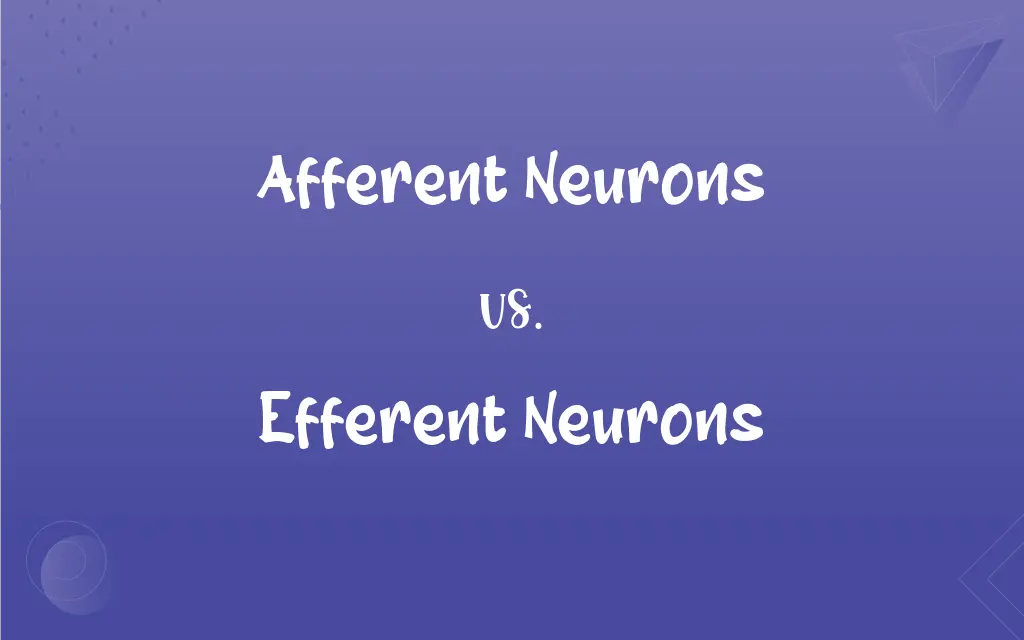Afferent Neurons vs. Efferent Neurons: What's the Difference?
Edited by Aimie Carlson || By Janet White || Published on January 5, 2024
Afferent neurons transmit sensory signals to the central nervous system, while efferent neurons convey motor commands from the central nervous system to muscles and glands.

Key Differences
Afferent neurons, also known as sensory neurons, are responsible for carrying sensory information from the body's tissues and organs to the central nervous system (CNS). Efferent neurons, or motor neurons, perform the opposite function by transmitting signals from the CNS to the body's muscles and glands, enabling actions and responses.
The role of afferent neurons is crucial in the sensory system, as they help the body perceive the environment through various senses like touch, taste, smell, sight, and hearing. Efferent neurons play a key role in the motor system, controlling voluntary and involuntary movements by activating muscles and regulating glandular secretions.
Afferent neurons have specialized receptor endings that respond to different types of stimuli, such as heat, light, or pressure. In contrast, efferent neurons have endings that connect with muscle fibers or gland cells, facilitating the contraction of muscles or the release of hormones and other substances.
The cell bodies of afferent neurons are typically located outside the CNS, in structures called dorsal root ganglia. For efferent neurons, their cell bodies are generally located within the CNS, specifically in the spinal cord or brain.
Afferent and efferent neurons together form the peripheral nervous system, with afferent neurons bringing information in and efferent neurons sending instructions out, thus maintaining the body’s response and interaction with the environment.
ADVERTISEMENT
Comparison Chart
Direction of Signal Transmission
From body tissues to CNS
From CNS to muscles and glands
Function
Transmit sensory information
Convey motor commands
Types of Stimuli Responded To
Heat, light, pressure, etc.
Muscle contractions, gland secretions
Location of Cell Bodies
Outside CNS (dorsal root ganglia)
Inside CNS (spinal cord or brain)
Role in Nervous System
Part of sensory pathways
Part of motor pathways
ADVERTISEMENT
Afferent Neurons and Efferent Neurons Definitions
Afferent Neurons
Sensory neurons that respond to external stimuli.
Light triggers the afferent neurons in the eyes.
Efferent Neurons
Neurons that transmit motor signals from the CNS to the body.
Efferent neurons stimulate muscle contraction during exercise.
Afferent Neurons
Neurons involved in conveying data about the body's state.
Afferent neurons help you feel the texture of an object.
Efferent Neurons
Cells that facilitate communication from CNS to muscles and glands.
Efferent neurons play a role in the release of digestive enzymes.
Afferent Neurons
Neurons transmitting information from sensory receptors.
Afferent neurons convey the pain sensation from an injury.
Efferent Neurons
Motor neurons controlling muscle actions and glandular responses.
Efferent neurons are essential for initiating movement.
Afferent Neurons
Neurons that carry sensory signals to the central nervous system.
Afferent neurons are activated when you touch a hot surface.
Efferent Neurons
Nerve cells involved in executing motor responses.
When you decide to stand up, efferent neurons activate your leg muscles.
Afferent Neurons
Nerve cells that send messages from the periphery to the brain.
The smell of food activates afferent neurons linked to the olfactory system.
Efferent Neurons
Neurons sending instructions from the brain to the periphery.
Efferent neurons cause your heart rate to increase during stress.
FAQs
What is the main function of efferent neurons?
The main function is to control muscle movements and glandular activity.
How do afferent neurons detect stimuli?
They have specialized receptors for different stimuli.
Are afferent neurons involved in reflex actions?
Yes, afferent neurons are part of reflex arcs.
Do efferent neurons directly interact with muscles?
Yes, they connect with muscle fibers.
Are afferent neurons part of the peripheral nervous system?
Yes, they are a component of the peripheral nervous system.
Where are the cell bodies of efferent neurons located?
Inside the CNS.
Can afferent neurons sense internal body conditions?
Yes, they can sense internal conditions like blood pressure.
What do afferent neurons transmit?
Afferent neurons transmit sensory information to the CNS.
Where do efferent neurons send signals?
Efferent neurons send signals from the CNS to muscles and glands.
How do efferent neurons affect heart rate?
They can increase heart rate by stimulating cardiac muscles.
Do afferent neurons have a role in taste?
Yes, they transmit taste information to the brain.
Can efferent neurons be repaired after injury?
Repair is limited, and regeneration is challenging.
Are efferent neurons involved in digestion?
Yes, they control the release of digestive enzymes.
What happens when afferent neurons are damaged?
Sensory information transmission can be impaired.
Do efferent neurons release neurotransmitters?
Yes, they release neurotransmitters at synapses with muscles or glands.
Do efferent neurons play a role in emotional responses?
Yes, they can be involved in physiological responses to emotions.
Do afferent neurons respond to temperature?
Yes, they can detect changes in temperature.
How do efferent neurons contribute to movement?
They initiate and control voluntary movements.
Are afferent neurons faster than efferent neurons?
Speed varies depending on the type of neuron and myelination.
Can afferent neurons be affected by diseases?
Yes, diseases like diabetes can affect afferent neurons.
About Author
Written by
Janet WhiteJanet White has been an esteemed writer and blogger for Difference Wiki. Holding a Master's degree in Science and Medical Journalism from the prestigious Boston University, she has consistently demonstrated her expertise and passion for her field. When she's not immersed in her work, Janet relishes her time exercising, delving into a good book, and cherishing moments with friends and family.
Edited by
Aimie CarlsonAimie Carlson, holding a master's degree in English literature, is a fervent English language enthusiast. She lends her writing talents to Difference Wiki, a prominent website that specializes in comparisons, offering readers insightful analyses that both captivate and inform.






































































